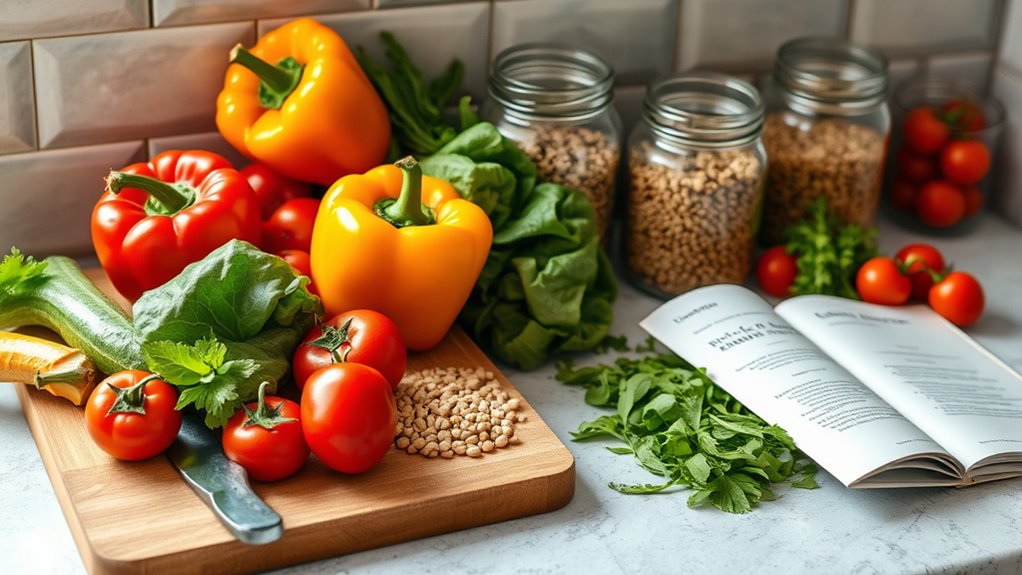To plan budget-friendly meals, create detailed grocery lists based on weekly meal plans and shop for staples like rice and beans in bulk. Focus on seasonal produce and shop sales to maximize savings. Prep meals in advance and portion them for busy days, reducing takeout costs. Incorporate affordable proteins like lentils or chickpeas to boost nutrition without breaking the bank. Following these tips can help you save money and eat well—learn more to get started today.
Key Takeaways
- Create weekly meal plans based on sales, seasonal produce, and versatile ingredients to maximize savings.
- Prepare and portion meals in advance, cooking large batches of staples like rice and stews for convenience.
- Use store brands, buy in bulk, and shop during sales to lower ingredient costs without sacrificing quality.
- Incorporate affordable plant-based proteins like lentils and chickpeas to cut expenses and boost nutrition.
- Enhance flavors with cost-effective ingredients like butter and seasonings, reducing reliance on expensive processed foods.

Planning meals on a budget doesn’t have to be stressful or restrictive. In fact, with a little planning and organization, you can enjoy nutritious, tasty meals without breaking the bank. The key is to approach grocery shopping strategically and incorporate effective meal prep techniques into your routine. When you plan ahead, you avoid impulse buys and reduce waste, saving money while still eating well.
Start by making a detailed grocery list based on your weekly meal plan. Check your pantry and refrigerator before heading to the store to see what essentials you already have. This prevents unnecessary purchases and helps you focus on what you truly need. When grocery shopping, opt for store brands—they’re often just as good as name brands but cost considerably less. Buying in bulk for staples like rice, beans, oats, and frozen vegetables is another smart move. These items are versatile, long-lasting, and can be used in a variety of inexpensive meals.
Meal prep plays a vital role in maintaining a budget-friendly diet. Dedicate a couple of hours each week to cooking and portioning out your meals in advance. This way, you’re less likely to order takeout or grab convenience foods that tend to be more expensive and less healthy. Preparing ingredients in bulk allows you to quickly assemble meals during busy weekdays. For example, cook a large batch of rice or pasta, roast a tray of seasonal vegetables, or prepare a big pot of chili or stew. Store these in airtight containers, so you always have ready-to-eat options that are both affordable and satisfying.
Another way to maximize your grocery budget is to incorporate seasonal produce and sales into your meal plan. When fruits and vegetables are in season, they’re cheaper and fresher, making your meals more flavorful. Keep an eye out for weekly flyers and discounts, and plan your meals around those deals. Also, consider plant-based proteins like lentils and chickpeas, which are less expensive than meat and can be used in a variety of dishes. Using these ingredients in your meal prep not only cuts costs but also boosts your intake of fiber and nutrients. Additionally, utilizing butter in your cooking can add flavor and richness to your meals without significantly increasing costs, especially when bought in larger quantities and stored properly.
Frequently Asked Questions
How Can I Meal Prep Efficiently on a Tight Schedule?
When you’re short on time, focus on time-saving techniques like batch cooking strategies. Dedicate a few hours once a week to prepare multiple meals at once, so you can simply reheat during busy days. Use versatile ingredients to create different dishes, and store everything in portioned containers. This approach minimizes daily cooking, helps you stay organized, and guarantees you always have healthy, homemade meals ready to go.
What Are Cost-Effective Protein Sources for Large Families?
Think of your grocery list as a treasure map—finding the X where savings and nutrition meet. For large families, cost-effective protein sources include bulk buying eggs, beans, and lentils, which are versatile and budget-friendly. Incorporate plant-based options like tofu or chickpeas to stretch meals further without sacrificing nutrition. These strategies turn everyday shopping into a hunt for value, making every dollar work harder for your family’s needs.
How to Avoid Food Waste When Planning Meals?
To avoid food waste, focus on meal portion control so you don’t prepare more than your family can eat. Implement smart grocery shopping strategies like making a detailed list and sticking to it to prevent impulse buys. Use leftovers creatively for future meals, and store perishables properly. These steps help you manage quantities better and reduce waste, saving money and ensuring your ingredients are used efficiently.
Are There Affordable Alternatives to Popular Organic Ingredients?
You’re wondering if there are affordable alternatives to popular organic ingredients. The good news is, you can opt for budget-friendly substitutions like local, seasonal produce or frozen organic options, which often cost less. Look for store brands or bulk purchases, and consider growing your own herbs or veggies. These choices help you enjoy the benefits of organic without overspending, making your meals both healthy and budget-conscious.
How Can I Incorporate Seasonal Produce Into My Budget Meals?
You can incorporate seasonal produce into your meals by prioritizing seasonal shopping, which often offers better prices and fresher options. Buy in bulk when possible, and preserve excess produce through freezing or canning to enjoy later. Incorporate versatile ingredients into various recipes, and plan meals around what’s in season. This approach helps you save money while enjoying nutritious, flavorful meals that highlight the best of each season.
Conclusion
Think of your meal plan as a garden—you plant wisely, tend regularly, and soon, it bursts with abundance. By embracing these budget-friendly tips, you’re cultivating a lush harvest without breaking the bank. Every dollar saved is like watering your roots, strengthening your ability to nourish yourself and your loved ones. Keep nurturing your culinary garden, and watch your savings—and your meals—flourish, turning everyday ingredients into a vibrant, sustenance-filled paradise.









